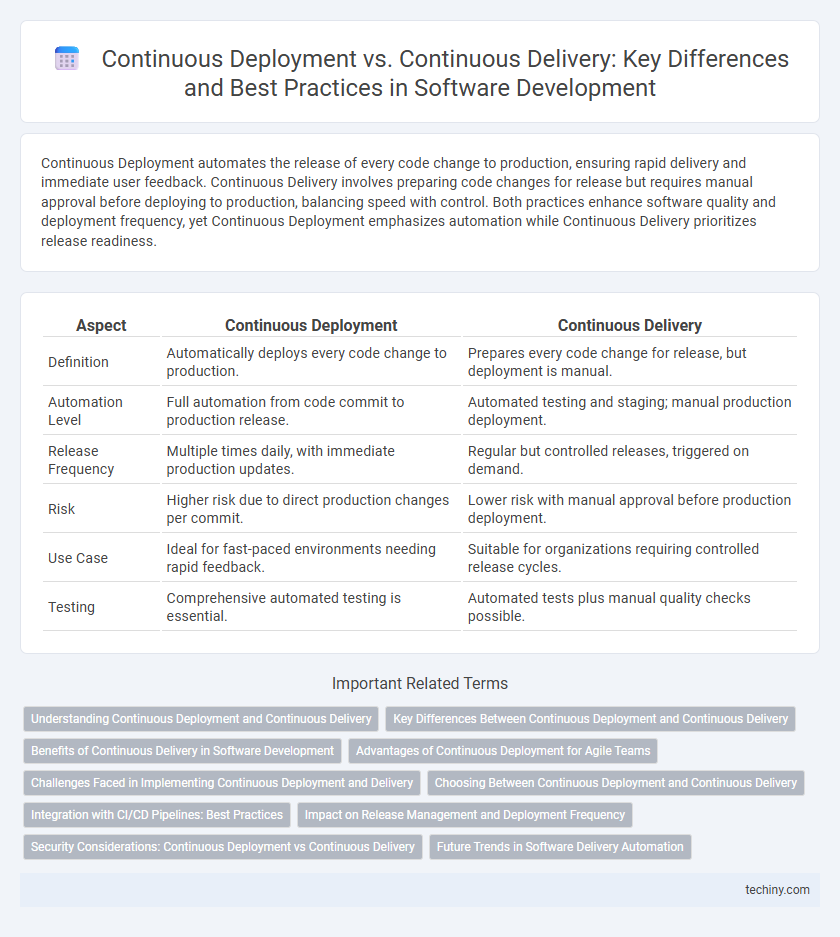Continuous Deployment automates the release of every code change to production, ensuring rapid delivery and immediate user feedback. Continuous Delivery involves preparing code changes for release but requires manual approval before deploying to production, balancing speed with control. Both practices enhance software quality and deployment frequency, yet Continuous Deployment emphasizes automation while Continuous Delivery prioritizes release readiness.
Table of Comparison
| Aspect | Continuous Deployment | Continuous Delivery |
|---|---|---|
| Definition | Automatically deploys every code change to production. | Prepares every code change for release, but deployment is manual. |
| Automation Level | Full automation from code commit to production release. | Automated testing and staging; manual production deployment. |
| Release Frequency | Multiple times daily, with immediate production updates. | Regular but controlled releases, triggered on demand. |
| Risk | Higher risk due to direct production changes per commit. | Lower risk with manual approval before production deployment. |
| Use Case | Ideal for fast-paced environments needing rapid feedback. | Suitable for organizations requiring controlled release cycles. |
| Testing | Comprehensive automated testing is essential. | Automated tests plus manual quality checks possible. |
Understanding Continuous Deployment and Continuous Delivery
Continuous Deployment automates the release of every code change to production after passing automated tests, minimizing manual intervention and accelerating delivery cycles. Continuous Delivery ensures that code changes are always in a deployable state, requiring manual approval before release to production, thus providing more control over deployments. Both practices aim to enhance software quality and speed but differ in automation levels and deployment timing.
Key Differences Between Continuous Deployment and Continuous Delivery
Continuous Deployment automates the release of every code change directly into production, ensuring rapid delivery and immediate feedback, while Continuous Delivery involves automated testing and staging but requires manual approval before production deployment. Continuous Deployment minimizes human intervention, enhancing deployment frequency and reducing time to market, whereas Continuous Delivery provides more control and reduces risk by allowing teams to decide when to release. Both practices rely on robust CI/CD pipelines, automated testing suites, and monitoring tools to maintain software quality and stability.
Benefits of Continuous Delivery in Software Development
Continuous Delivery significantly enhances software development by enabling teams to release reliable and thoroughly tested code at any time, reducing deployment risks and improving software quality. It fosters faster feedback loops through automated testing and staging environments, which accelerates bug detection and resolution. This approach ensures consistent, repeatable releases and greater collaboration between development, operations, and QA teams, driving efficiency and customer satisfaction.
Advantages of Continuous Deployment for Agile Teams
Continuous Deployment accelerates software release cycles by automating the delivery process, enabling Agile teams to rapidly respond to user feedback and market changes. This approach reduces manual intervention, minimizing human error and increasing deployment frequency, which enhances product quality and customer satisfaction. Agile teams benefit from continuous integration with immediate updates, fostering a culture of collaboration and continuous improvement.
Challenges Faced in Implementing Continuous Deployment and Delivery
Implementing Continuous Deployment requires overcoming challenges such as ensuring robust automated testing to prevent faulty releases and managing infrastructure capable of supporting frequent production updates without downtime. Continuous Delivery faces difficulties in maintaining a seamless integration pipeline and coordinating between development and operations teams to allow rapid yet controlled software releases. Both practices demand overcoming resistance to cultural change and investing in advanced monitoring and rollback mechanisms to minimize risks associated with rapid deployments.
Choosing Between Continuous Deployment and Continuous Delivery
Choosing between continuous deployment and continuous delivery depends on the team's tolerance for risk and the maturity of the CI/CD pipeline. Continuous deployment automates every code change directly to production, ideal for organizations with robust automated testing and monitoring systems. Continuous delivery ensures code is always production-ready but requires manual approval before deployment, providing greater control for teams prioritizing stability over speed.
Integration with CI/CD Pipelines: Best Practices
Integrating Continuous Deployment and Continuous Delivery within CI/CD pipelines requires automating testing stages to ensure code quality and minimize manual intervention, enhancing deployment frequency. Employing feature flags and canary releases in Continuous Delivery allows controlled rollout, while Continuous Deployment emphasizes immediate production release after successful integration. Utilizing robust monitoring tools and maintaining rollback strategies solidify pipeline reliability and rapid issue resolution.
Impact on Release Management and Deployment Frequency
Continuous Deployment automates the entire release process, enabling multiple deployments per day and significantly increasing deployment frequency, which accelerates feedback loops and reduces time-to-market. Continuous Delivery, while maintaining deployment readiness at all times, requires manual approval for releases, resulting in lower deployment frequency but greater control over release timing. Both approaches improve release management by promoting automation and reducing release risks, yet Continuous Deployment optimizes for rapid, consistent delivery while Continuous Delivery emphasizes stability and oversight.
Security Considerations: Continuous Deployment vs Continuous Delivery
Continuous Deployment automates the release of every code change to production, increasing the risk exposure if security vulnerabilities are not caught early, whereas Continuous Delivery involves manual approval before deployment, allowing for enhanced security verification and risk mitigation. Implementing robust automated security testing, such as static application security testing (SAST) and dynamic application security testing (DAST), is critical in Continuous Deployment to prevent the introduction of insecure code. Continuous Delivery workflows benefit from additional security audits and compliance checks during the manual approval stage, reducing the likelihood of deploying compromised software.
Future Trends in Software Delivery Automation
Future trends in software delivery automation emphasize increased integration of AI and machine learning to enhance Continuous Deployment pipelines, enabling faster and more reliable releases. Continuous Delivery strategies will increasingly adopt automated quality assurance and security checks to maintain compliance while accelerating deployment cycles. The evolution of cloud-native technologies and container orchestration will further streamline both Continuous Deployment and Delivery processes, supporting scalable and resilient software delivery frameworks.
Continuous Deployment vs Continuous Delivery Infographic

 techiny.com
techiny.com